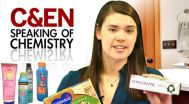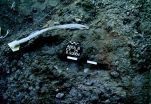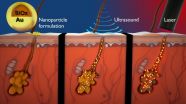Milky Way's center unveils supernova 'dust factory'
2015-03-19
(Press-News.org) Sifting through the center of the Milky Way galaxy, astronomers have made the first direct observations - using an infrared telescope aboard a modified Boeing 747 - of cosmic building-block dust resulting from an ancient supernova.
"Dust itself is very important because it's the stuff that forms stars and planets, like the sun and Earth, respectively, so to know where it comes from is an important question," said lead author Ryan Lau, Cornell postdoctoral associate for astronomy, in research published March 19 in Science Express. "Our work strongly reinforces the theory that supernovae are producing the dust seen in galaxies of the early universe," he said.
Lau explains that one of astronomy's big questions is why galaxies - forming as recently as 1 billion years after the Big Bang - contain so much dust. The leading theory is that supernovae - stars that explode at the end of their lives - contain large amounts of metal-enriched material that, in turn, harbors key ingredients of dust, like silicon, iron and carbon.
The astronomers examined Sagittarius A East, a 10,000-year-old supernova remnant near the center of our galaxy. Lau said that when a supernova explodes, the materials in its center expand and form dust. This has been observed in several young supernova remnants - such as the famed SN1987A and Cassiopeia A. In the turbulent supernova environment, scientists expect the churning dust to be destroyed. "That is theoretically," Lau said. "There have been no direct observations of any dust surviving the environment of the supernova remnant ... until now, and that's why our observations of an 'old' supernova are so important," he said.
The astronomers captured the observations via FORCAST (the Faint Object Infrared Camera Telescope) aboard SOFIA (the Stratospheric Observatory for Infrared Astronomy), a modified Boeing 747 and a joint project of NASA, the German Aerospace Center and the Universities Space Research Association. It is the world's largest airborne astronomical observatory. Currently, no space-based telescope can observe at far-infrared wavelengths, and ground-based telescopes are unable to observe light at these wavelengths due to the Earth's atmosphere.
Joining Lau on this research, "Old Supernova Dust Factory Revealed at the Galactic Center," are co-authors Terry Herter, Cornell professor of astronomy and principal scientific investigator on FORCAST; Mark Morris, University of California, Los Angeles; Zhiyuan Li, Nanjing University, China; and Joe Adams, NASA Ames Research Center.
INFORMATION:
ELSE PRESS RELEASES FROM THIS DATE:
2015-03-19
Researchers from Banner Alzheimer's Institute (BAI) have developed a new brain image analysis method to better track the progression of beta-amyloid plaque deposition, a characteristic brain abnormality in Alzheimer's disease, according to a study published in the March issue of the Journal of Nuclear Medicine. Investigators also believe this new approach may make it easier to evaluate investigational anti-amyloid treatments in clinical trials.
During the last decade, researchers have been using positron emission topography (PET) to assess amyloid plaque deposition in ...
2015-03-19
A psychology study from The University of Texas at Austin sheds new light on today's standards of beauty, attributing modern men's preferences for women with a curvy backside to prehistoric influences.
The study, published online in Evolution and Human Behavior, investigated men's mate preference for women with a "theoretically optimal angle of lumbar curvature," a 45.5 degree curve from back to buttocks allowing ancestral women to better support, provide for, and carry out multiple pregnancies.
"What's fascinating about this research is that it is yet another scientific ...
2015-03-19
WASHINGTON, March 19, 2015 -- It's a simple claim made on thousands of personal care products for adults and kids: hypoallergenic. But what does that actually mean? Turns out, it can mean whatever manufacturers want it to mean, and that can leave you feeling itchy. Speaking of Chemistry is back this week with Sophia Cai explaining why "hypoallergenic" isn't really a thing. Check it out here: http://youtu.be/lXh8bnqMOZs.
Speaking of Chemistry is a production of Chemical & Engineering News, a weekly magazine of the American Chemical Society. The program features fascinating, ...
2015-03-19
The Canadian research community on high-temperature superconductivity continues to lead this exciting scientific field with groundbreaking results coming hot on the heels of big theoretical questions.
The latest breakthrough, which will be published March 20 in Science, answers a key question on the microscopic electronic structure of cuprate superconductors, the most celebrated material family in our quest for true room-temperature superconductivity.
This result is the product of a longstanding close collaboration between the University of British Columbia Quantum ...
2015-03-19
Some 2.5 million years ago, early humans survived on a paltry diet of plants. As the human brain expanded, however, it required more substantial nourishment - namely fat and meat - to sustain it. This drove prehistoric man, who lacked the requisite claws and sharp teeth of carnivores, to develop the skills and tools necessary to hunt animals and butcher fat and meat from large carcasses.
Among elephant remains some 500,000 years old at a Lower Paleolithic site in Revadim, Israel, Prof. Ran Barkai and his graduate students Natasha Solodenko and Andrea Zupanchich of Tel ...
2015-03-19
DENVER, March 23, 2015 -- Since HIV emerged in the '80s, drug "cocktails" transformed the deadly disease into a manageable one. But the virus is adept at developing resistance to drugs, and treatment regimens require tweaking that can be costly. Now scientists at the 249th National Meeting & Exposition of the American Chemical Society (ACS) are announcing new progress toward affordable drugs that could potentially thwart the virus's ability to resist them.
ACS, the world's largest scientific society, is holding the meeting here through Thursday. It features nearly 11,000 ...
2015-03-19
Washington, D.C.--To combat global climate change caused by greenhouse gases, alternative energy sources and other types of environmental recourse actions are needed. There are a variety of proposals that involve using vertical ocean pipes to move seawater to the surface from the depths in order to reap different potential climate benefits. A new study from a group of Carnegie scientists determines that these types of pipes could actually increase global warming quite drastically. It is published in Environmental Research Letters.
One proposed strategy--called Ocean ...
2015-03-19
What if there were a pill that made you more compassionate and more likely to give spare change to someone less fortunate? UC Berkeley scientists have taken a big step in that direction.
A new study by UC Berkeley and UC San Francisco researchers finds that giving a drug that changes the neurochemical balance in the prefrontal cortex of the brain causes a greater willingness to engage in prosocial behaviors, such as ensuring that resources are divided more equally.
The researchers also say that future research may lead to a better understanding of the interaction between ...
2015-03-19
URBANA, Ill. - Over the last several decades there have been substantial yield improvements in soybean. Because of new varieties and new agronomic practices, the yield potential in soybean is higher now than ever before. But a lack of updated information on the nutritional needs of soybean crops may be limiting the crop's potential.
Researchers from the University of Illinois Crop Physiology Laboratory led by Fred Below have recently provided an updated set of nutrition needs for soybean, identifying exactly which nutrients the plant needs, when those nutrients are accumulated ...
2015-03-19
Acne, a scourge of adolescence, may be about to meet its ultra high-tech match. By using a combination of ultrasound, gold-covered particles and lasers, researchers from UC Santa Barbara and the private medical device company Sebacia have developed a targeted therapy that could potentially lessen the frequency and intensity of breakouts, relieving acne sufferers the discomfort and stress of dealing with severe and recurring pimples.
"Through this unique collaboration, we have essentially established the foundation of a novel therapy," said Samir Mitragotri, professor ...
LAST 30 PRESS RELEASES:
[Press-News.org] Milky Way's center unveils supernova 'dust factory'



